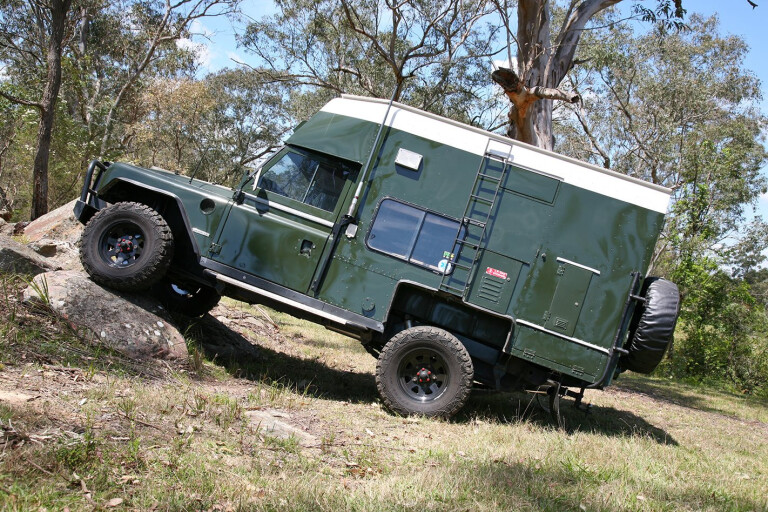
YOU'VE got to love those old Meccano and Lego kits of your childhood that allowed you to make just about anything from a pile of blocks and tubes, plus bits and pieces left over from other projects – all held together with a few nuts and bolts.
This article was first published in 4x4 Australia's January 2011 issue.
The same goes for Land Rovers, but you’ll need to throw in a heap of rivets to hold it all together. It makes life easy knowing you can use parts from the early model vehicles right up to the latest and greatest derivation of that vehicle – that’s what makes the Series I, II and III, right up to the latest Land Rover Defender so attractive to modify into everything from hard-core competition rigs to brilliant outback touring vehicles.
Alan Ryrie has taken great pleasure in doing just that, utilising Land Rover parts spanning almost half a century to come up with this camper unit that has served him and his wife well on plenty of trips. The base unit consists of totally stock-standard 1982 station wagon, with just over 270,000km on the clock, complete with a smooth-running four-cylinder 3.9-litre Isuzu diesel engine and a rust free chassis.
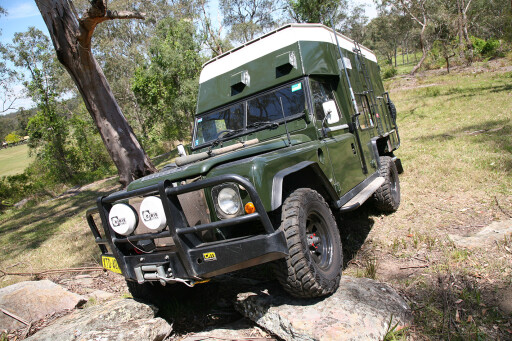 Alan then picked up a 1963 ex-army ambulance body from a Series IIA that had served the hard yards in Vietnam and had been pretty much wrecked and left to die. Right from the get-go, this project was to serve as a camper unit for two, so no need for any extra seating or the expense of carrying extra bodies around – neither passengers, nor patients.
Alan then picked up a 1963 ex-army ambulance body from a Series IIA that had served the hard yards in Vietnam and had been pretty much wrecked and left to die. Right from the get-go, this project was to serve as a camper unit for two, so no need for any extra seating or the expense of carrying extra bodies around – neither passengers, nor patients.
While the engine remains mostly standard, Alan has fixed it up slightly with a ported head and, as you can see from the photos, totally cleaned it – good enough to eat off. Behind the Isuzu block, a four-speed manual gearbox, courtesy of a Range Rover, has been mated to an LT95 transfer case.
The transfer case has had a high-speed gear set installed to help with those long on-road hauls. As with all these Landie models, the drive system remains full-time 4X4 (anything else would be sacrilege) and final drive is via the standard 3.5 ratio open diffs.
 A three-inch exhaust system was fitted to help rid the gases from the slow revving diesel engine, but the engine air intake remains as standard. Speaking of air intake, this old Land Rover doesn’t have air-conditioning, rather it has roof vents (outside, above the windscreen) and internal screw-on caps (courtesy of the plumbers section at the hardware store) to allow cross ventilation.
A three-inch exhaust system was fitted to help rid the gases from the slow revving diesel engine, but the engine air intake remains as standard. Speaking of air intake, this old Land Rover doesn’t have air-conditioning, rather it has roof vents (outside, above the windscreen) and internal screw-on caps (courtesy of the plumbers section at the hardware store) to allow cross ventilation.
The faster you drive, the more air rushes through the vents. Simple! Oh, and for what it’s worth, you’ll get a little extra air into the cab with those standard, rather restrictive sliding windows.
The most comprehensive change to this truck – other than that whopping camper/ambo back – is to swap the front leaf spring set to a coil spring version, which Alan borrowed from a 110 Defender. Power steering – also donated from a 110 – was added at the same time.
The front end offers higher levels of comfort, improved steering and better off-road performance – and it’s all 100 percent genuine Land Rover. The standard rear leaf-spring pack has had a few extra leaves added (a substantial 10 leaves in the pack) to help carry the additional weight of the ambulance body and extra camping gear inside.
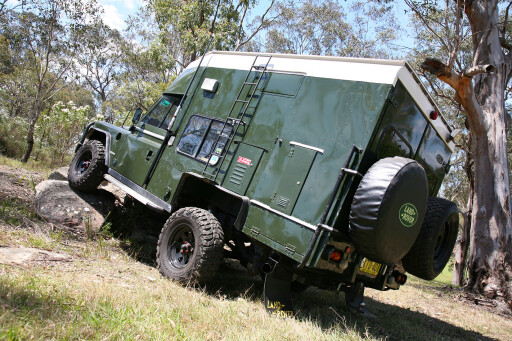 Not that this Landie has more power than standard, but Alan figured the ability to bring the whole show to a stop was pretty important, so he swapped the brakes for solid discs on the front and larger drums on the rear – again from a later model 110 Defender.
Not that this Landie has more power than standard, but Alan figured the ability to bring the whole show to a stop was pretty important, so he swapped the brakes for solid discs on the front and larger drums on the rear – again from a later model 110 Defender.
A full set of six Kumho KL71 mud tyres at 31x10.5R15 on 15x7-inch Speedy black steel rims not only look the part, but provide plenty of grip off-road. The two spares reside on the swing-open rear barn doors and don’t impede off-road clearances.
At the front end, a TJM steel bullbar has been fitted, together with a low-mount 9000lb electric winch and a pair of Cibie Super Oscar driving lights. A fine mesh screen clips onto the standard grille to help prevent bugs and grass seeds getting into the radiator while driving.
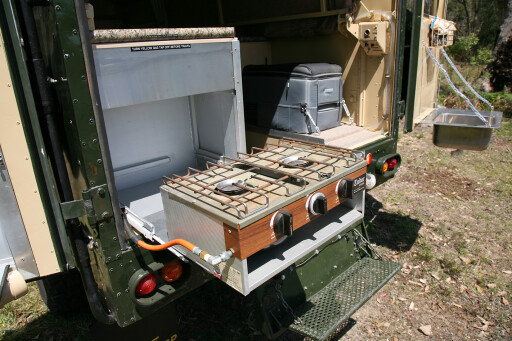 A pair of N70ZZ-sized batteries serves duty for cranking and deep-cycle work of accessories, lighting and running the Waeco fridge. Standard Defender bucket seats are used in favour of the original pews, while the centre console and steering wheel all account for ‘minor upgrades’ of sorts.
A pair of N70ZZ-sized batteries serves duty for cranking and deep-cycle work of accessories, lighting and running the Waeco fridge. Standard Defender bucket seats are used in favour of the original pews, while the centre console and steering wheel all account for ‘minor upgrades’ of sorts.
Alan uses a Hema Navigator and takes an Iridium satphone for safety’s sake on extended trips. Carrying a whole host of spares and being mechanically knowledgeable (he did build this vehicle himself), we’d presume Alan could repair most breakdowns if needed.
The camping set-up in the ambulance section has been kitted out with fold down beds (similar to how the original ambo stretchers folded down from the sides). Under the beds are cupboards and storage units which are easily accessible when the beds are lifted.
 The high roof, complete with second skin (tropical roof), allows for reasonably comfortable inside temperatures, day and night. That second skin prevents the sunshine coming into direct contact with the main roof (to keep it cool) and at night, helps reduce condensation while sleeping inside.
The high roof, complete with second skin (tropical roof), allows for reasonably comfortable inside temperatures, day and night. That second skin prevents the sunshine coming into direct contact with the main roof (to keep it cool) and at night, helps reduce condensation while sleeping inside.
The two rear barn doors carry fold-down tables and sinks for quick and easy access, plus the two-burner gas cooker slides out of a recessed compartment – again for easy access. Alan has also tucked a 50-litre water tank under his Landie which makes its way into the kitchen area via a 12-volt pump.
Should he ever need to chop fire wood, dig himself out of a bog hole or belt an intruder over the back of the head in self-defence, all the tools needed are conveniently attached to the aluminium checker plate-lined bonnet.
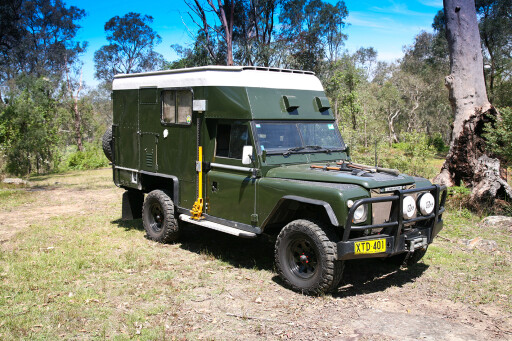 Lifting the Landie by either the bullbar, side rails or rear bar work is done with a trusty high-lift jack, securely attached just behind the driver’s door. As you walk around the Landie, you notice absolutely every little switch, button and lever is duly labelled. Who knows what the multitude of gadgets do? [You could read the label.]
Lifting the Landie by either the bullbar, side rails or rear bar work is done with a trusty high-lift jack, securely attached just behind the driver’s door. As you walk around the Landie, you notice absolutely every little switch, button and lever is duly labelled. Who knows what the multitude of gadgets do? [You could read the label.]
I’m guessing Alan got an Dymo labelling machine for his birthday one year and went absolutely ballistic with it! All up, this camper unit is exceedingly simple in its layout and construction, but y’know what? It works a treat!
Why be fancy when simple does the job?

COMMENTS